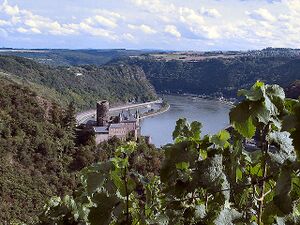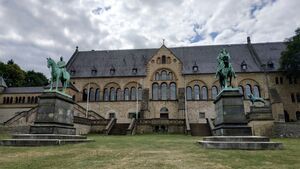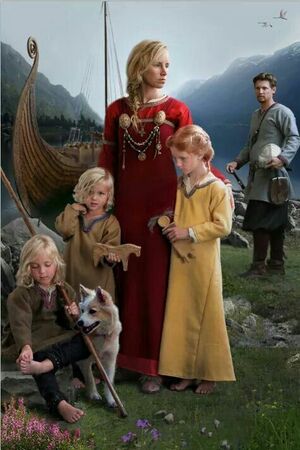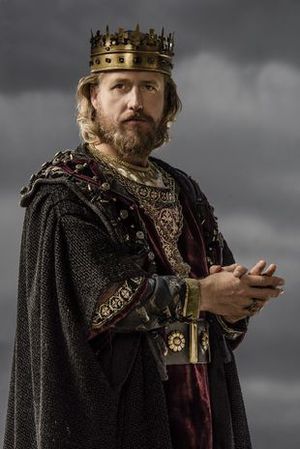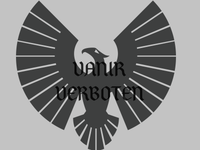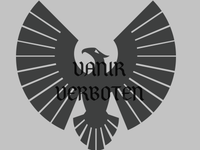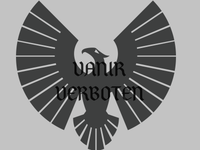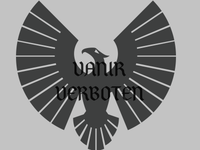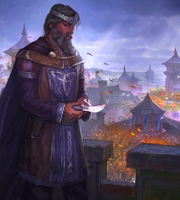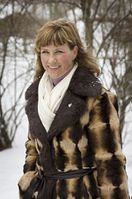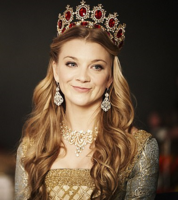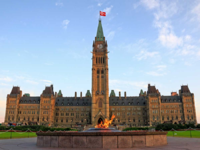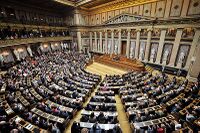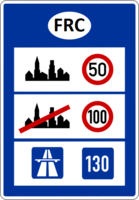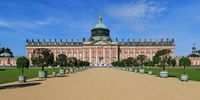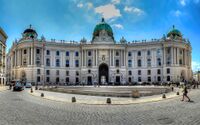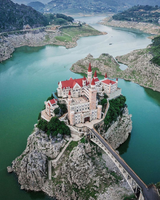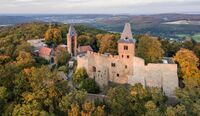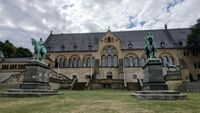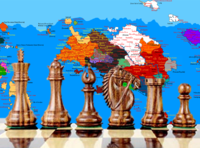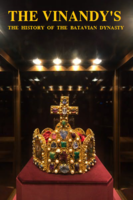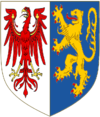West Amokolia/West Amokolia under Frankish occupation
(For reference only. Revision into an Amokolian historical narrative pending.)
| Fränkisches Reich Frankish Empire Imperium Francorum | |||
| |||
| Motto: In Freiheit vereint Unified in freedom Unum liberum | |||
| Anthem: | |||
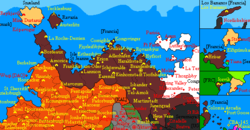
| |||
| Map versions | 9.4b – 16.6.4 (as Amokolia) 16.6.5 - present (as Francia) | ||
| Capital | Brandenburg | ||
| Largest city | Brandenburg, Frankfurt-am-Oder, Hyfrost and Colonia Arcadia | ||
| Official language(s) | Germanian, Common Tongue | ||
| Official religion(s) | Holy Catologian Church | ||
| Demonym | Franconian, Frankish | ||
| - Adjective | Franconian, Frankish | ||
| Government | Parliamentary Constitutional Monarchy | ||
| - Kaiser von Francia (Emperor of Francia) | Arkadius Frederik Gustavus des Vinandy | ||
| - Chancellor | Augustin Prager | ||
| - Legislature | Reichstag | ||
| Establishment | 1504 AN as Amokolia 1678 AN as Francia | ||
| Area | 2,755,008 km2 (until 1680) | ||
| Population | Active real-life participants: 3 Simulated population: 82,040,386 (1679 AN, the liberated Froyalaners added. In 1681 AN, Gascony, Los Bananos and Ravaria added.) | ||
| Active population | 3 | ||
| Currency | Reichsmark | ||
| Calendar | |||
| Time zone(s) | CMT-9, CMT+2 and CMT+12 | ||
| Mains electricity | |||
| Driving side | right | ||
| Track gauge | |||
| National website | |||
| National forum | [1] | ||
| National animal | Amokolian Goose (Branta canadensis) | ||
| National food | Cabbage (Brassica oleracea) | ||
| National drink | Beer | ||
| National tree | Sessile oak (Quercus petraea) | ||
| Abbreviation | FRC | ||
Francia, officially the Frankish Empire, (Germanian: Fränkisches Reich; Catologian: Imperium Francorum) is a forum and wikibased country whose main part is located on the Benacia continent. Lying between the Great Western Sea in the west, the Northern Sea in the north and the foot of the Octavian mountains in the south. It borders Batavia in the southwest, Kalgachia in the south, Benacia in the southeast and the Amokolian Republic (Elwynn) in the east. The other parts of Francia are located on the continents of Apollonia and Keltia.
The predecessor of the Frankish Empire is West Amokolia, also known as the Kingdom of Amokolia (Germanian: Königreich Amokolien; Mishalanese: Королество Амоколия, Korolestvo Amokoliya), which existed since 1504 AN. The revival of the Kingdom of Amokolia came after the Kalirion Fracture, when the country was formed as a kingdom under the rule of Arkadius Frederik Gustavus des Vinandy, from the House of Vinandy. In 1678 AN, West Amokolia adopted a new constitution which saw the name of the state changed to Francia. Since 1679 AN Francia is a member of the Batavian Confederation.
The capital of Francia is the city of Brandenburg. The city was founded when the revival of the Kingdom of Amokolia took place, because the original capital Anun of the former Amokolia was not part of the kingdom. This newly built city houses the parliament, the Reichstag, and the various government institutions.
Francia is a member of the Batavian Confederation (Germanian: Batavisches Bund) and the Franco-Batavian Empire.
Etymology
The name "Francia" is derived from the adjective "franc", which means "free, liberal, generous". This term has been adopted as a connecting element between the different ethnicities: free and sovereign of foreign domination.
Sometimes Francia is referred to as Frankia with a k sound to match the adjective Frankish. Although that spelling is technically incorrect.
The Frankish Empire was proclaimed in Frankfurt-am-Oder (Frankfurt on the Oder), where the Constitutionem Vadum Francorum (Constitution of Frankfurt) was adopted.
Name in other languages:
| Long | Short | |
|---|---|---|
| Batavian | Frankische Rijk | Frankenrijk |
| Catologian | Imperium Francorum | Francorum |
| Germanian | Fränkisches Reich | Frankenreich |
| Elw | Реқи Ференги Reqi Ferengi |
Ференги Ferengi |
| Froyalanish | Frankar ríkir | Frankaríki |
| Jorvish | Frenċisċra rīċe | none |
| Mishalanese | Франкская Империя Frankskaya Imperiya |
Франкия Frankiya |
| North Amokolian | Frankënen Rijk | Frankërijk |
| Norse | Frankerriket | Frankerriket |
National symbols
The national symbols of the Frankish Empire are:
Coat of arms
The coat of arms of the Frankish Empire is the highest heraldic symbol of the state. Its shield has four quarters: one quarter represents Amokolia, one Jorvik, and a further two quarters for Los Bananos and Gascony. An escutcheon on the shield shows the Vinandy arms. A Willems crown is on top of it all, with a golden crowned lion and a white eagle acting as supports. Finally, the coat of arms is set against a red cloak adorned with golden bees, lined with gold and ermine, tied with strings, and with a canopy under the Emperor's own crown. The motto, translated to English, is "United in Freedom".
Flag
- Main article: Flag of Francia
The flag of the Frankish Empire is based on the flag of West Amokolia. The cross is however changed into an asymmetrical cross (Scandinavian cross), with the middle of that cross hidden by a red eagle on a white circle. The eagle is known as a Brandenburger eagle, and is also found on the coats of arms of some of the cities of Francia.
Anthem
No national anthem is recorded in the constitution, but the introduction of the new constitution played the "Kaiserhymne" (emperor hymn). A text on this hymn has not yet been written, just as the Vinandy song has no text. The Vinandy song was scattered across the border towards Benacia and Elwynn, when there were hate campaigns against the Empire.
Geography
The Frankish Empire has several classifications for the different areas under the Frankish flag. This is how it is spoken about:
- Territorial classification, to describe physical geography;
- Cultural classification, describing the population groups and culture; and
- Political classification, to describe the administrative classification.
Territorial classification
The territory on Benacia is referred to as "Benacian Francia" or "Francia media" (Middle Francia). The territories on Apollonia are referred to as "Francia Orientalis" (East Francia). The territories on Keltia are referred to as "Francia Occidentalis" (West Francia).
Francia Media
The western coastline of the Ortanian Peninsula is rough, with many islands, peninsulas, headlands and bays. On the north side is the Strait of Shalta, an important shipping route for the northern cities of Francia westwards. On the Ortanian Peninsula lies the Ortanian ridge, which gradually slopes eastwards to the east coast of the peninsula into the Northern Sea.
The Gascon Lowlands are bordered by the coast of the Northern Sea and the Ingelse ridge in the south. From the west border, several smaller rivers and streams flow north into the Northern Sea, the largest being the Oder and Sheyn. The Oder is a branch of the Sheyn, which originates in the Octavian Mountains. Wetlands and swampy conditions can be found around the Oder.
The Froyalan coastline is characterized by cliff rocks, interrupted by north-flowing watercourses. The Stasia Plateau on the northeast coast is steeper, with many glacier-shaped features in the coastline and lakes. From the border of Batavia tames the Gänslein Kamm (Gosling Ridge) the river Elce, which flows northeast. The ridge is densely forested, while to the north there is less and less forest to be found due to the colder climate.
South of the Elce is a rugged and somewhat patternless hilly and mountainous landscape. The south-western border lies at the foot of the Octavian mountains, while on the south-eastern border lies the Mishalan plateau, from where the Blue Elwynn originates. The eastern border traverses a hilly landscape that extends to the eastern coast.
Wendoland is bordered by the coast of the Northern Sea to the east, the Stasia plateau in the north and the transition to the hilly landscape to the west. The area is densely forested, in great contrast with the open hilly landscape of Tsofnland.
Francia Orientalis
There are two separate Frankish regions on the Apollonia continent: Arietta and Jorvik. These areas are part of "East Francia" or "Francia Orientalis".
Arietta is bordered on the north by the Northern Sea. Only 60 km (37.28 mi) is between the north cape near Elðgrímskaupstaður and the Storish island of Vinland. On the south side, Arietta borders on the Green. That border is marked by border posts, despite the heavily forested area concealing the transition from Arietta to the Green.
Jorvik is situated at the confluence of the rivers Hvítá and Trysilelva. The rocky coast makes the area difficult to reach, except at the river mouth where the city of Jorvik is located. The landscape is interspersed with forests and grassland.
Francia Occidentalis
West Francia consists of a peninsula and an archipelago. The peninsula is characterized by a steeply sloping mountain ridge. The island north of the peninsula is in fact a part of this same ridge that has broken loose. The rocky islands are covered with windswept grass fields.
Political classification
Autonomous regions
The Frankish Empire comprises several autonomous regions. Each region has its own agreements on the degree of autonomy. Mishalacia, for example, has an activity requirement.
| Flag | Coat of Arms | Region | Capital | Land area (km2) | Population | Head |
|---|---|---|---|---|---|---|

|
Autonomous Province of Mishalacia | Janezgrad | TBD | TBD | Svobodan Milošev Governor | |
| Kingdom of Ravaria | Tecklenburg | TBD | TBD | Æsileif Haraldsdóttir Queen of Ravaria |
Crownlands
The overseas territories of the Frankish Empire, which are part of Francia Occidentalis and Francia Orientalis, are classified as crownlands (Germanian: Kronländer). At the head of each crownland is a governor appointed by the Kaiser. A crownland has a high degree of independence and often has its own culture.
| Flag | Coat of Arms | Crownland | Capital | Land area (km2) | Population | Governor | Time zone |
|---|---|---|---|---|---|---|---|
| County of Anglia | Jorvik | TBD | TBD | TBD | CMT+2 | ||
| Duchy of the Lady Esther Isles | Port Esther | 9,288 | TBD | TBD | CMT+10 | ||

|
Greater Gosling | Colonia Arcadia | 92,952 | TBD | Joela Le Droumaguet | CMT+9 | |

|
Duchy of Los Bananos | Los Bananos | TBD | TBD | TBD | CMT+7 | |
| United Government around the Northern Sea | United Government around the Northern Sea | United Government around the Northern Sea | Wiltenborg | TBD | 16,831,064 (Arietta) | Gisela Starck | CMT-1 and CMT-3 |
Gaue
The territory of the Frankish Empire, which is designated as Francia Media and is not part of an autonomous region, is divided into Gaue. A Gau is comparable to a Shire. In the Frankish state system, a Gau is seen as a province with a governor at the head. Each Gau has a directly elected governor as well as a parliament. The name of this parliament can differ per Gau.
| Flag | Coat of Arms | Gau | Capital | Land area (km2) | Population | Governor |
|---|---|---|---|---|---|---|

|
Absentia | Earendil | TBD | TBD | TBD | |

|
Agningas | Corrigible | TBD | TBD | TBD | |

|
Amorica | Amorica | TBD | TBD | TBD | |

|
Aquitaine | Bordeaux | TBD | TBD | TBD | |

|
Hauptstadtregion Brandenburg | Brandenburg | 7,128 | TBD | Eleonora Bluhm | |

|
Froyalan | Haraldsstadt | TBD | TBD | TBD | |

|
Gascogne | La Roche-Derrien | TBD | TBD | TBD | |

|
Isle St Jean | Pierrefeu | 13,248 | TBD | TBD | |

|
Izaria | Tel-Amok | TBD | TBD | TBD | |

|
Mishalan | Noahroi | TBD | TBD | TBD | |

|
Neustria | Lannion | TBD | TBD | TBD | |

|
Oleslääd | Tsofnhafen | TBD | TBD | TBD |
Maps
As an extension of the Batavian detailed map, a detailed map of Francia is being worked on. The detailled maps as so far:
History
Prehistory on Benacia
On the first MCS map that still exists, all of Benacian Francia, Batavia and many other areas were under the control of Commune of Paramount. On the second MCS map, the same areas are under the control of Machiavellia, which transferred to the United Republic of Tymaria on 31.XV.1461. After six Norton years, the republic fell into chaos and disappeared from the map.
For a short time parts of the southeast of Benacian Francia were under the control of Europae Concordia. After that the Empire of Nova Roma came into existence for a short time, but after the fall Commonwealth of Puritania expanded eastwards. The northern part was known as Northeaston, but changed to the Principality of Saxony. The city of Frankfurt, nowadays Frankfurt-am-Oder, appeared on the map.
On the east coast, together with parts of contemporary Elwynn, the Principality of Greater Automatica existed for a short time, which soon became part of Shireroth. Greater Automatica became Bjorngard and the remaining area of then Benacia became the Confederacy of Independent States. Among these states were Ariel, the Kingdom of Gosling and Stasia, but the confederation disappeared from the map in 1519 AN.
Ancient Amokolia
- Main article: History of Amokolia
Amokolia was originally founded on 22.VI.1504. The pre Micrasian era consisted of a turbulent history, with at least ten monarchs succeeding each other. King Jess X establish the constitution and brought Amokolia to Micras. The first territory consisted of the Automatica islands, then the territory expanded to continental Benacia.
In 1540 AN, Amokolia joined the newly formed Gralan Empire for four Nortonyears. After Amokolia became independent for thirteen Nortonyears, the country became part of the Ocian Federation. The country was liberated during the Amokolian War (1556-1557 AN).
But after two Norton years, Amokolia became part of the Victorian Empire. Only the Victorian Empire was not as stable as hoped, after which Amokolia was annexed by Elwynn. Under Elwynnese flag, East Amokolia became part of Shireroth, while the remainder became a protectorate of Natopia. Later, as an imperial domain, Amokolia expanded westward. But after the Froyalanish genocide, Amokolia disappeared from the map.
Gascony
In 1532 AN the Duchy of Gascony was founded as part of the United Kingdoms of Bosworth and Gascony. Soon the duchy got a southern neighbour: Batavia. That country was attacked from Gascony and initiated the Gascony War: 1555 - 1556 AN. Gascony was divided between Batavia, the western part, and Stormark, the eastern part. After the fall of Batavia in 1614 AN, all Gascony came under the control of Stormark. With the Treaty of the Northern Hereditary Lands, Gascony came under the flag of Francia.
Revival of Amokolia
The chaos during the Kalirion Fracture made the area, which forms the Kingdom of Amokolia, a forgotten area. Shirerian troops concentrated on the greater unrest elsewhere in Shireroth, allowing terrorists to seize the opportunity to revolt. The Amokolian Highlanders were helped by the Batavian Knights Charitable and Hospitaller of Amokolia to get the area under control. The turning point came when the realization came that the area could no longer count on support from Shirekeep. A hastily convened meeting of dignitaries and military leaders led to the declaration of independence through the Declaration of Brandenburg.
The king of Batavia, Arkadius Frederik Gustavus des Vinandy, was invited to become king of Amokolia. His coronation was on 22.VI.1672, exactly 168 years after the foundation of Amokolia. In support of the Amokolian armed forces, the king already sent his personal military unit, the Tassity Mansabdar, to restore order. In 1672 AN, the Amokolian Highlanders invaded Mishalan and a demarcation line was agreed with Benacia. Elwynn had also invaded Mishalan and thereby blocked the advance to the Blue Elwynn. Instead, the city of Mittlere Stadt came under Amokolian control.
The government of Amokolia consisted of a military council. The transition to a parliamentary democracy began in 1674 AN with the first Reichstag elections. The Conservatives won the majority with 68 out of 100 seats. The remaining seats belonged to the Amokolian Freedom Front. Augustin Prager became the first chancellor, after which the army withdrew from political institutions.
The Froyalanish Genocide was recognized in 1674 AN. Ever since the revival of Amokolia, the still existing labour camps with remaining Froyalaners have been closed. In Brandenburg the "Valfreyja monument" (Freyja of the Slain) was unveiled. The recognition met with much criticism from the other vulture states and even hostility, with the result that the Franco-Kalgachi border and the Franco-Benacian border were closed.
Still, in 1675 AN the Treaty of Concord was concluded with Elwynn and the Unified Governorates of Benacia. With this it was acknowledged that the short form was to be West Amokolia and not the simple Amokolia:
- [Elwynn, West Amokolia and the Unified Governorates of Benacia] recognize that the historic homelands of the Amokolians, known as Amokolia, is shared between them. Neither of the Parties claim to be the sole homeland of the Amokolian people. As such, the Kingdom of Amokolia shall be referred as "The Kingdom of Amokolia" or "West Amokolia". "Amokolia", without qualification, shall refer to the entirety of West Amokolia, Severnaya Gubernya and Elwynnese Amokolia.
The Unified Governorates of Benacia soon cancelled the treaty and Elwynn also threatened to cancel the treaty. In West Amokolia the "Frank und Frei Bewegung" (frank and free movement) emerged, which strongly opposed the term "West Amokolia". This started the process which led to the renaming of the country.
The city of Jorvik came under the control of Amokolia in 1674 AN. Arkadius Frederik Gustavus des Vinandy received the title "Lord in Jorvik" at his marriage to Clara Sundara Waffel-Paine. In the Reichstag the king declared: "It is strange to be ‘Lord in Jorvik’ without actually being lord in Jorvik”.
Frankish Empire
- Main article: Timeline of Francia
On the day the Frankish Empire was proclaimed, the Second Amokolian War had already begun. Elwynn had violated the sovereignty of the country, which together with the United Governments of Benacia and Ransenar, carried out hostile actions. The conflict caused the royal plane, which was en route to 's Koningenwaarde, to return, and not much later Prince Gustavus Nathan des Vinandy was born in Brandenburg. The third child of the now Emperor Arkadius Frederik Gustavus des Vinandy and and his then wife Clara Sundara Waffel-Paine, is the first child born on Amokolian soil, now the Frankish Empire. The newborn prince was granted the title "Marquis of Dornick".
The war accelerated the already coming Wende (transition). The elections for the Reichstag would take place, but were postponed. That is why a special session was held in the Kaiserpaltz (Kaiser Palatinate) in Frankfurt-am-Oder. The new constitution, called "Constitutionem Vadum Francorum" (Common Tongue: Constitution of Frankfurt; Germanian: Frankfurter Reichsverfassung), was adopted and Francia was founded. The Second Amokolian War was officially over on 1.VII.1679 AN.
On 1.VII.1680 AN, the city of Mittlere Stadt, which came under Frankish administration eight years earlier, was returned to Elwynn in exchange for the liberation of 166,328 Froyalaners. Arietta was obtained at the same time.
Demographics
Since the census of 1669 AN, where the population of the then Kingdom of Amokolia amounted to 3,565,849, Francia has experienced explosive population growth. The addition of areas is the main cause of this.
The addition of the city of Chryste to the Frankish Empire led to an immediate addition of 3,340,500 people. Earlier the city of Jorvik came under the Frankish flag, which in 1632 AN had 4,812,154 inhabitants, with thereafter a steady development of 1.5% on average and the increase in population of 2.5% on average since the annexation.
Port Goose had 12,218 inhabitants in 1645 AN, but that number grew, so that in 1678 AN claimed more "lebensraum" (living space). The population in Greater Gosling reached 21,288 people in the census of 1679 AN.
The census of 1679 AN counts that the combined population of Francia amounts to: 17,899,021. After Chryste was ceded to the Verionian Empire, the population is 14,538,478. In 1680 AN, 166,328 Froyalaners were liberated, which brings the population to 14,704,806.
Froyalaners
The Froyalaners were an endangered population group in Francia until 1674 AN. That changed when Froyalan refugees from neighbouring Storish Gascony returned. A method has been developed that allows sterilized men to become fertile again. As a result, the number of Froyalaners in 1679 AN is 235,477.
With the Treaty of Mittlere Stadt, a total of 166,328 Froyalaners were liberated from the countries of the Raspur Pact.
Lingua franca
The lingua franca or language of the Franks is Germanian. All official documents and actions are performed in this language. The Common Language is used in diplomatic relations, which means that various treaties have been drafted in this language.
Government
At the revival of the Kingdom of Amokolia, the country was ruled by a military council. After the king's coronation, more and more of the government was transferred to civilian institutions. When the revolution (Wende) took place, during which the Frankish Empire was founded, the new constitution established a constitutional monarchy with a parliamentary democracy.
Kaiser
- Main article: Kaiser von Francia
The Kaiser (emperor) of Francia is the head of state. He represents the empire, signs the laws and appoints government officials. The duties and powers of the Kaiser are laid down in the constitution. The powers of the Kaiser include declaring war and making peace, signing treaties, leading the armies and fleets, granting grace, raising nobility and granting knighthood and veto over all decisions of the Reichstag.
The Kaiser is assisted by a Reichsrat, who advises him on the execution of his duties and powers. The day-to-day administration of the empire can the Kaiser assign to a Kanzler (Chancellor) with additional Reichministers to be appointed.
The first Kaiser von Francia is His Majesty Arkadius Frederik Gustavus des Vinandy. On 22.VI.1672 he was crowned King of Amokolia, a title that he still holds, despite the fact that the then Kingdom of Amokolia has been transferred to the Frankish Empire.
Imperial family
The imperial family consists of the people who are the first line in relation to the Kaiser. This concerns the parents of the Kaiser, the wife of the Kaiser and the legal children of the Kaiser. Further family of the Kaiser are not formally part of the imperial family, but can be counted among the extended imperial family.
The contemporary imperial family consists of:
- Esther Fatima Gudrid des Vinandy of the Houses of Ayreon-Kalirion and of the Descendants of Freyja, the second wife of the Kaiser: Her Royal Imperial Highness, Empress consort of Francia;
- Elisabeth Asara des Vinandy, the oldest daughter of the Kaiser: Her Royal Imperial Highness the Princess of Austrasia;
- Karel Kyle des Vinandy, the oldest son of the Kaiser: His Royal Imperial Highness the Prince of Vinandy;
- Gustavus Nathan des Vinandy, the youngest son of the Kaiser: His Royal Imperial Highness the Marquis of Dornick;
- Frederik Harald des Vinandy, the youngest son of the Kaiser: His Royal Imperial Highness the Earl of Markland;
- Ærinndís Theodora des Vinandy, the youngest daughter of the Kaiser: Her Royal Imperial Highness the Earla of Lyonesse;
- Fränzi-Fjǫrleif des Vinandy, the third oldest daughter of the Kaiser: Her Royal Imperial Highness the Earla of Vórgota;
- Noor Charlotte des Vinandy, the youngest daughter of the Kaiser: Her Royal Imperial Highness the Earla of Myrthelan;
- Elisabeth des Vinandy - van Hollandt, the mother of the Kaiser: Her Royal Imperial Highness the Empress Mother.
Until 11.X.1678 AN, Clara Sundara Waffel-Paine was the wife of the Kaiser, giving her the titels "Empress consort of Francia" and "Queen consort of Amokolia". But since their divorce, all Frankish titles to Clara have lapsed.
The extended imperial family consists of the distant relatives of the Kaiser. According to the constitution, these family members cannot claim succession to the throne, but they are seen as affiliated with the Kaiser:
- Harald Freyjugjöf, High King of Stormark, the great-grandfather of the Kaiser and the title "Duke of Froyalan" has been granted to him;
- Ærinndís Ettlingar Freyu, she is not a direct relative of the Kaiser in terms of bloodline, but is linked to the House of Vinandy through her marriage to the late Arkadius Leopold des Vinandy;
- Æsileif Haraldsdóttir, the grandmother of the Kaiser and the title "Princess of Amokolia" has been granted to her.
- Margaery des Vinandy, Princess of the Beneluccas.
Succession
The succession of the Kaiser is constitutionally determined by male line. As a result, not the oldest child of the Kaiser is the first in line of succession, but his second child and oldest son: Karel Kyle des Vinandy. This method of succession is in line with Prima Divisio des Vinandy, the house treaty of the House of Vinandy.
Immediately after the death of the Kaiser, his successor is the new Kaiser. The new Kaiser still has to be crowned. There is no established ceremony, since a change of throne has not yet taken place, only the constitutional provision for the continuation of imperial authority.
Regent and Reichsrat
After the Kaiser's marriage to Esther Fatima Gudrid, she was appointed Regent. A Regent performs imperial duties in absence of the Kaiser or at his request. Especially when the Kaiser dies and his successor has not yet reached adulthood, the Regent acts instead of the Kaiser.
The Reichsrat is the advisory for the Kaiser. Members of that council are:
- Æsileif Haraldsdóttir
- Esther Fatima Gudrid des Vinandy of the Houses of Ayreon-Kalirion and of the Descendants of Freyja
- Johan Anderion Avon-El Ayreon-Kalirion
The Reichsrat meets at the Jess Palace on the Unter den Eicken.
Kanzler and Reichministers
Reichstag
- Main article: Reichstag
The Reichstag is the parliament of the Frankish Empire. It was founded at the proclamation of the Kingdom of Amokolia in 1672 AN as a continuation of the Amokolian Saenate. The first elections followed in 1674 AN, but after the Wende, during which the Frankish Empire was formed, the tasks and powers were laid down in the new constitution. Since the constitution was adopted, a ratio has been established between the number of inhabitants of Francia and the number of seats. This ratio is 75,000 citizens per seat, but due to the addition of 67 million inhabitants after the connection of Gascogne, Los Bananos and Ravaria, this was adjusted. The constitution was amended, making the ratio 100,000 citizens per seat. Every two Norton years, one third of the seats are elected.
The Reichstag proposes a chancellor to the Kaiser. This is usually the leader of the largest fraction in the Reichstag. Since the revival of the Kingdom of Amokolia and then the Wende to the Frankish Empire, there has only been one Chancellor: Augustin Prager.
The Reichstag is represented by the President of the Reichstag (Germanian: Reichstagspräsident). The president is elected by the members of the Reichstag; it is customary for the president not to be supplied by the governing party or parties. Since 1684 AN, Katharina Ehlers, a member of the Fränkische Patriot Partei, has been elected President of the Reichstag.
Foreign Relations
- Main article: Foreign relations of Francia
Francia profiles itself as an independent country and the most free nation on Micras. Foreign policy at the time of the Kingdom of Amokolia was aimed at good neighbourliness, but because of the hostile attitude of many neighbouring countries, a policy of "Splendid isolation" was pursued. After the Second Amokolian War, foreign policy was formulated as "Splendid Allies".
As a result of the de facto personal union with Batavia and Helderbourgh, Francia maintains friendly relations with these countries. Even to the extent that in 1679 AN Francia joined the Batavian Confederation.
Compared to the various other Vulture States, Amokolia is not a member of the Raspur Pact. Although previous incarnations and protector states of the Kingdom of Amokolia were members of the Micras Treaty Organization, Francia is not a member.
Military
Civilians with weapons
Although not part of the army, Francia maintains the fundamental right of self-defence. The possession and carrying of firearms is permitted, with the only restriction that one must be an adult and that weapons must be registered. Only a judge can cancel or restrict possession and carrying of weapons.
As a result, many citizens have weapons in their possession. Almost every city or village has a shooting range, where citizens can practice. In some places civilian militias are formed, which organize tactical exercises. The possession, as well as the public carrying of weapons, is promoted by various organizations. More weapons are sold if there are tensions at the borders of the empire.
Military service
Every citizen is called up for military service at the age of eighteen. There is no distinction between men and women. Exceptions are possible, such as on grounds of health, height and when two older brothers and sisters are already or have been in military service. Military service can also be postponed, for example, so as not to interrupt an ongoing study.
After military service, men and women become part of the reserve army, insofar as they do not continue in the professional army. The reserve army can be summoned in the event of a threat of the kingdom, in addition there are compulsory annual exercises. The military service lasts two to three years, participation in the reserve army until the age of forty.
Imperial Army
- Unofficial list of the Equipment of the Imperial Frankish Army
The size and equipment of the Kaiserliche Fränkische Armee (Imperial Frankish Army) is shrouded in mystery. There are no official figures available. At the foundation of Francia, the imperial army was drastically reformed, but the Amokolian Highlanders and Batavian Knights Charitable and Hospitaller of Amokolia were classified as units within the army. As a separate army unit is the Kaiserliche Garde (Imperial Guard), which is responsible for protecting the imperial family and property.
Just like the size and equipment of the Imperial Frankish Army, the budget is unknown, and even more so: a state secret. The only thing known is that during the Second Amokolian War Stormark donated two trillion Ríkskróna to Francia. The use of that donation is unknown.
There are rumours that the army has an arsenal of nuclear and biological weapons, as well as directed-energy laser weapons. For the protection of the territory it is known that an "Eisenschild" (iron shield) has been set up, with which all enemy missiles and planes would be shot from the sky.
Ever since the revival of Amokolia, the personal military unit of the emperor, the Tassity Mansabdar, has been active. This unit is not part of the Imperial Frankish Army, but works closely together and only responds to the Nawab of Tassity. The unit has its own staff, facilities and equipment.
Secret Service
There is an intelligence service in Francia, which is constitutionally attached to the emperor. But no head office is known and even the name of the service is not known. That is why people talk about the "Geheimdienst" (secret service) or the "Kaisermänner" (Emperor men). The service is referred to as "Brandenburg" in official documents.
Economy
Energy
Upon the independence of the Kingdom of Amokolia, the country inherited the power plants from Shireroth. Due to overdue maintenance, several nuclear power stations were not safe enough. The kingdom has temporarily purchased electricity from Elwynn. But soon the government started working on renewing the energy supply and replacing the electricity grid.
Today, the last old Shirerian power plants are shut down and the energy supply consists of the combination of new small nuclear plants, molten salt plants and gas plants. The electricity grid has been completely replaced and set up redundant. There is national coordination of energy supply, but generated locally.
The molten salt power plants are a unique and pioneering development. The supply of thorium is sufficient for the energy supply for the next hundred years. The new nuclear power stations were built as a bunker with local storage of nuclear waste. This means that transport of nuclear waste is not necessary. Some nuclear power stations are combined with an isotope reactor (intended for medical use) and the enrichment of uranium.
Transport
The Reichsautobahn, which is translated as the "Imperial highway", is the national motorway network in Francia. Large parts of the Reichsautobahn has no mandated speed limit for passenger cars. However, limits are posted (and enforced) in areas that are urbanised, substandard, accident-prone, or under construction. On speed-unrestricted stretches, an advisory speed limit (Richtgeschwindigkeit) of 130 km/u (81 mph) applies. While driving faster is not illegal as such in the absence of a speed limit, it can cause an increased liability in the case of a collision (which the mandatory auto insurance has to cover); courts have ruled that an "ideal driver" who is exempt from absolute liability for "inevitable" tort under the law would not exceed Richtgeschwindigkeit.
The construction of the Reichsautobahn started after the revival of the Kingdom of Amokolia. The old highways from the Shirerian era were converted or even completely rebuilt. In particular after Brandenburg was founded as the capital, new routes of the Reichsautobahn were built.
In addition to the Reichsautobahnen, there are Reichsstraßen, which, like Reichsautobahnen, have separate driving directions, but the maximum speed is limited to 100 km/hour. These roads are also numbered, but according to the numbering of the Landesstraßen. The Landesstraßen is the regional road network that connects each town.
Culture
Amokolian Day
- Main article: Amokolian Day
Independence day is held 22 Weidemouth, the day on which on 22.VI.1504 Amokolia was founded, as well as the revival in the form of the Kingdom of Amokolia 168 Norton years later. This gave the day the name "Amokolian Day". The celebration of that day became popular after the Wende, when the Kingdom of Amokolia transferred to the Frankish Empire. The festivities in Brandenburg consist of a "march of the geese", a military parade on the avenue Unter den Eicken and a tattoo with closing fireworks.
Beer culture
Francia is a beer country. Most Frankish beers are cool bottom -fermented and are considered the best cool bottom- fermented beers from Micras. Especially in the area around Gänslein Kamm there is a high density of breweries. The city of Babenberch is centrally located in this area, where the traditional and national drink Rauchbier (smoked beer) comes from.
Most beers are brewed according to the Reinheitsgebot (purity command). This means that beer can only contain malted barley, water and hops. Moreover, the commandment prohibits the use of herbs and fruits. However, there are also beers that deviate from this, this is called Freibier (free beer). It is therefore mandatory to state on the packaging that it is a Freibier.
Bierfest
Every year the Bierfest (beer festival) is celebrated. The Bierfest is opened by a parade of brass bands, floats and the first beer barrel. The partygoers wear traditional costumes, the "lederhose" for men and the "dirndl" for women. The Bierfest is celebrated in large tents, beer halls and beer gardens.
The national first beer barrel is tapped by the Kaiser. This is done locally by the mayor or other local administrator. Only beer approved by the Brandenburg Bierhaus may be served, often only Frankish beers. The beer is served in a special beer mug, which is removed from the mug safe for this occasion. The beer mug of the Kaiser is picked up with a grand ceremony from the mug safe in Vinandy.
Traditional music is played during the festivities, often with a large "Oom-pah-pah" part:
Castles, palaces and Kaiserpfalzen
The landscape of Francia is dotted with castles, palaces and Kaiserpfalzen. Due to the rich history of the country, as well as the cultural backgrounds of different areas, there are different terms for the different buildings. There is, for example, a distinction between buildings such as: castle, Schloss, Burg, palace, hof, Kaiserpfalzen, and so on.
Calendar
The Frankish calendar is a combination of the Norton calendar and Gregorian calendar. The era is the same as the Norton calendar, but the months are the same as the Gregorian calendar with its own names. The calendar thus corresponds to the New Batavian Calendar, as used in Batavia.
- January: Eismond (Ice Month)
- February: Taumond (Dew Month)
- March: Lenzmond (Spring month)
- April: Blühendermond (Flowering Month)
- May: Weidemond (Meadow Month)
- June: Brachmond (Fallow Month)
- July: Heumond (Hay Month)
- August: Erntemond (Harvest Month)
- September: Herbstmond (Autumn Month)
- October: Weinmond (Wine Month)
- November: Nebelmond (Misty Month)
- December: Düstermond (Dark Month)
Cuisine
Goose Feet Cookies (Germanian: Gans Füße Kekse) these cookies are named for their intriguing folded shape. They're flavoured with orange zest and vanilla bean and owe their light, flaky texture to a beloved ingredient: farmer's cheese.
The recipe was thought lost when the Portogeese left for Goose Island. This was partly due to the fact that not all ingredients were available, but with the Frankish unification of Goose Island and the original habitat of the Portogeese on the Benacian continent, the recipe was immensely popular in the area on and around the Gänslein Kamm.
Media
In Francia there is a wide variety of media. Freedom of the press is a fundamental right to which great value is attached. There are no media that are wholly or partially in the hands of the state. TV broadcasts of public events, such as the music show "Amokolian Feeling", are broadcast by auction on national TV channels.
Francia's best watched daily news show is "Brandenburger Aktuelles" (Brandenburg Actual). The best read newspaper is the "Brandenburger Post", this newspaper appears in the Germanian. Other newspapers are the "Le Duc" and "Quill and Arrow". These news media are considered leading and revealing, like the revelations by the Brandenburger Post about the equipment of the Imperial Frankish Army.
Foreign newspapers are often available in major cities, such as the Arcadian newspaper "Y Ffagl Calbain" and the Batavian newspaper "'s Koningenwaarder Courant".
Sports
Francia is not very well known for her sporting achievements, but sports are enjoyed on a large scale. The most popular sports are: chess, curling, golf, ice hockey, soccer, shooting and swimming.
Soccer
After the revival of the Kingdom of Amokolia began the restart of the football teams. But also many new teams made their entrance. The best teams of Francia play in the Frankish Premier League (Germanian: Erste Liga).
In 1685 AN the first soccer match is planned between Batavia and Francia. This promises to be a classic, because in the run-up to it healthy rivalry is already emerging.
Stories
The Frankish Empire plays a role in various story series. In these story series the cultural aspects and politics of the country are described more than once.
Active participants
Various active participants are taking part in Batavia:
- User:Gustaaf Vermeylen
- The person behind the character Esther Fatima Gudrid
- User:Ric
| |||||
| ||||||||||||||||||||||||||||||


